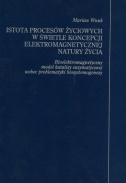
M. Wnuk: Istota procesów życiowych w świetle koncepcji elektromagnetycznej natury życia: Bioelektromagnetyczny model katalizy enzymatycznej wobec problematyki biosystemogenezy. Lublin: Redakcja Wydawnictw KUL; 1996, ss. 280. [in Polish] [Zakończenie] [Spis treści] [The essence of life processes in the light of the concept of electromagnetic nature of life: Bioelectromagnetic model of enzymatic catalysis in view of the problems connected with biosystemogenesis][Contents]
Summary
The essence of life processes in the light of the concept of electromagnetic nature of life: Bioelectromagnetic model of enzymatic catalysis in view of the problems connected with biosystemogenesis
The aim of this dissertation is to explore a new information-electromagnetic aspect of the nature of life in the context of the philosophy of systems and information, using the hypothetical-deductive method. Special attention is paid to two classes of the most important biological processes: enzymatic catalysis and biosystemogenesis. Taking them as examples, a new approach to the essence of life processes is proposed, in which life is seen as a form of existence, processing, and generation of electromagnetic information. In the light of results of empirical and theoretical investigations, concerned mainly with the entities and processes of the submolecular level of living systems (that so far have been omitted in the studies on the essence, origin, and evolution of life), biosystems should be considered as fermion-boson-infon systems functioning as specific condensates of information. In this context, a definition of life has been formulated according to which life is a specific electromagnetic information that organizes its corpuscular vehicle which is permanently in the metastable excited state and able to initiate laser action. As a result of this, the biological information may be transferred to other types of vehicles, not necessarily of the electromagnetic nature. It seems that in the context of contemporary philosophical and scientific knowledge on the living phenomena and processes, this type of approach is more satisfying than the ones according to which the life is considered e.g. a form of existence of protein bodies.
Most of the current investigation on biogenesis accepts the idea of chemical evolution. This idea was based on the assumption that life originated from the systems that had been ruled exclusively by the laws of physics and chemistry. In this work an attempt was made to apply the idea of the evolution of information and considered as a more fundamental one. Consequently, life should be treated as having originated from the systems governed by the laws of this evolution. Also, the physico-chemical systems should be subject to such evolution. These systems began to function as the carriers of electromagnetic, biologically-significant information, e.g. aluminosilicate autocatalytic physical plasma systems, which might have the distant descendants - the present autocatalytic RNA and enzymatic proteins.
According to the bioelectromagnetic model of enzymatic catalysis presented in this work, biocatalysts function not only as quantum generators of biophotons, but also as nanoprocessors of information. It has been shown that the fundamental mechanisms of enzymatic catalysis involve also bioplasma, i.e. physical plasma present in biosystems. By showing that, the concept of electromagnetic nature of life has been extended in the direction of energy-information relations.
This model was developed in two aspects. Both of them, i.e. bioelectronic and bioplasma ones, seem to be of great interest to the philosophy of nature. The importance of the bioelectronic attitude consists in taking into consideration the lowest level of the organization of living processes reached by the present empirical methods as well as physicochemical and electronic theories on which these methods have been based. The elaboration of the bioplasma aspect is of importance to philosophy because bioplasma is considered as a state of matter unique to living systems. In spite of reaching the stage when bioplasma might be studied by means of the "standard" methods of the present biophysics and biochemistry, it has not been yet investigated empirically. This established that acceptance of the knowledge on the essence of enzymatic catalysis may be of paramount significance. It goes far beyond the questions of application of the enzymes in biotechnology, biomolecular electronics or even medicine; it reaches also the area of the fundamental, yet very intricate question of the essence and origin of life.
As far as the two latter questions are concerned (which in terms of knowledge are of more importance than e.g. mechanisms of action of enzymes and their use in industry), the system-and-information approach allowed to formulate the following conclusions:
1) Life, being a specific type of information conveyed by the electromagnetic carrier, may be spread out thanks to its ability to induce catalytic processes and to control them. As a result, the fermion-boson-infon systems are re-organized into individual systems that are enhanced in infons and bosons.
2) The difference between living and the so called inanimate systems consists mainly in the quality and quantity of infons; the living organism may be considered not only a supercondensate, but also as a processor and generator of information.
3) Life on Earth originated from the information conveyed by the electromagnetic carrier, whereas the primordial living systems were probably macromolecular catalysts capable of functioning as cavity resonators of coherent electromagnetic radiation. In the context of this, it is claimed that the present understanding of the minimal living system and the minimal complexity of biostructures are not adequate. A macromolecule or a system at the sub-cellular level of organization should be considered as a minimal living unit.
4) Probably, the coupling between chemical and electronic processes was taking place in the molecule of the catalytic pre-RNA. It seems that this type of autocatalyst was an essential step in the developmental process of the minimal living being. It played the role of an indispensable structural and functional component of that system.
5) The classical understanding of fundamental living processes, collectively labeled as metabolism, should be modified by shifting the stress from the conversions of mass and energy to the information processing. Therefore, the existence of "organisms", mechanisms or systems capable of processing information and energy exclusively (energo-information) should have been expected.
6) The reconstruction of an electromagnetic biosystemogenesis will be possible if the new data, further confirming the new concepts, hypotheses and theories concerning the feasibility of the existence of such systems (or even their components) will be obtained as, e. g.:
- biosystems as photoelectronic computers,
- the elementary (minimum) unit of life as nanoprocessor of infons,
- entire organisms as systems of processors of electromagnetic and quantum-acoustic information,
- data on the physical paleo-environment on our planet, etc.
7) In connection with the above theses (1-6), one should postulate the establishment of bioinfonics, a new discipline of science that would be complementary to both bioelectronics and biophotonics. The same may be said about infodynamics - an analogue of electro- and thermodynamics.
8) Considered from the philosophical point of view, the bioelectromagnetic model of catalysis seems to enable the alleviation the antagonisms between mechanism and vitalism in their radical formulations. On one hand, the possibility of approaching life as an information process (with all its consequences) testifies against mechanism. On the other one, the involvement of physical plasma processes in biocatalysis may be considered as an argument against vitalism. Both exclusive approaches may be made more conceptually coherent on the ground of bioplasma and electromagnetic-information research approaches.
It seems that the system-information formulation, thanks to the recently gained ability to assess the information content of enzymes and their complexes, will make possible a significant progress in learning of the essence of life and in the reconstruction of its genesis. Moreover, this kind of approach adds a very important dimension to the understanding of life. In this information aspect of bioelectromagnetic processes, information should be regarded as an essential component of reality - Universum, rather than an epiphenomenon of energetic interactions.
The proposed approach provides also an attractive starting point for investigation as well as a new tool to undertake an attempt to overcome the old dilemma. Namely: is the origin of life an emergence of something entirely new or, is it rather a step by step process of transformation of something that is already present.
Hopefully, this approach and the results arrived at in this work will broaden the horizons of our current knowledge. Thanks to them, the new ones will appear not only in the realm of life sciences, but also in the philosophy of nature that functions in a close cooperation with all branches of science.
góra strony
Contents
Introduction [11]
1. Life as a form of the existence of electromagnetic information? [17]
1.1. On the relation "life = light" [18]
1.1.1. The historic-cultural aspect [18]
1.1.2. The historic-philosophical aspect [20]
1.2. Basic concepts of the electromagnetic nature of life [23]
1.2.1. Wlodzimierz Sedlak's electromagnetic theory of life [24]
1.2.2. Dwight H. Bulkley's electromagnetic theory of life [29]
1.3. Information as the essence of the Universe and life [31]
1.4. Life processes as a specific form of the existence of electromagnetic information [36]
2. Bioelectronic aspect of enzymatic catalysis [49]
2.1. Enzymatic catalysis as an essential group of biological processes [50]
2.1.1. The role of enzymes seen from the point of view of the classical paradigm of life sciences.[51]
2.1.2. The role of enzymes seen from the point of view of the bioelectronic paradigm in the life sciences [53]
2.2. The possibility of formation of the bioelectromagnetic model of enzymatic catalysis [55]
2.2.1. The substrate-structure-function analogies between enzymatic systems and electronic devices [55]
2.2.2. The use of enzymes in biomolecular electronics [61]
2.3. Previous proposals relating to the electronic mechanisms of biocatalysis [67]
2.3.1. Semiconducting mechanism of enzyme activity [68]
2.3.2. Piezoelectric theory of enzymatic catalysis [73]
2.3.3. Hypotheses on the involvement of superconductivity in the processes of enzymatic catalysis [78]
2.4. Enzymes as nanoprocessors: processing functions of enzymes in bioelectronic technology and in living systems [81]
2.5. Enzymes as quantum generators [85]
2.6. Bioelectronic dimension of the origin and evolution of enzymes [87]
3. Involvement of bioplasm a in enzymatic catalysis [91]
3.1. The possibility of the occurrence of physical plasma in enzymatic systems [92]
3.1.1. Macromolecules of enzymes and supramolecular structures [94]
3.1.2. Liquid phase surrounding enzymes [98]
3.2. Probale quantitative conditions for the existence of plasma state in enzymatic systems [100]
3.2.1. Criteria for the existence of plasma state in physical systems [100]
3.2.2. Qualifying criteria for the type of plasma in condensed phase [104]
3.3. Plasma biosystems of enzyme systems [105]
3.3.1. Plasma domains and their characteristics [106]
3.3.1.1. Electronic plasma [106]
3.3.1.2. Dipole plasma and ionic plasma [121]
3.3.2. The origin and effects of plasma domains [130]
3.3.3. The functions of plasma domains - possibility of coupling between plasma parameters with thermodynamic and kinetic characteristics of enzymatic reactions [132]
4. Philosophical dimension of enzymatic catalysis [147]
4.1. The classical approach [148]
4.1.1. Enzymes and epigenesis and integration on the molecular level of life [149]
4.1.2. The question of enzymes in the context of a philosophical discussion on the problem of essence and origin of life [152]
4.2. The system-information approach [155]
4.2.1. Biosystems as "computers" [155]
4.2.2. Enzymes as processors of mass, energy and information [160]
4.2.3. The possibility of information influence of the environmental electromagnetic fields on bioprocessors [167]
4.2.4. Biogenesis as information process vs. catalytic properties of ribonucleic acids [172]
5. Biosystemogenesis from in the light of the concept of electromagnetic nature of life [179]
5.1. Biosystems as the systems of fermions-bosons-infons [181]
5.2. The origin of fermion biosystems [186]
5.3. The origin of energetic biosystems (biobosons) [190]
5.4. The origin of information biosystems (bioinfons) [192]
5.5. Electronic biosystems vs. the primordial environment of life [197]
5.5.1. Bioelectronic systems: energetic-information interactions [198]
5.5.2. Bioelectronic model of abiogenesis and the role of electronically significant environmental conditions of protoliving systems [202]
5.6. Bioinfonics as a theoretical foundation of electromagnetic biosystemogenesis [204]
Conclusion [207]
Bibliography [215]
Summary [277]
góra strony
dane wprowadził: Andrzej Zykubek
Ostatnia aktualizacja: 26.08.2013, godz. 14:23 - Andrzej Zykubek




